Paper
Paper is made by forming a felted mat of intertwining fibers. This is done by passing a liquid suspension of the fibers through a screen. When the water drains away, the sheet is removed from the screen and allowed to dry. Because the fibers are mainly cellulose (the basic structural component of plant cell walls), their interaction with water and their adherence to one another create the strength and flexibility that are characteristic of paper.
The first paper was made from macerated tree bark, plants, and grass by the Chinese in A.D. 105, and sizing (filling the paper surface to reduce the spread of ink) had been developed in China by A.D. 700. The art of papermaking traveled from China to Korea and Japan and then to the Arab world, where rags were first used as the raw material for the fibers.
When papermaking spread to Europe, the beginnings of mechanization appeared with the first use of the stamper, a device for more speedily macerating the rag into pulp. By 1495 papermaking was practiced throughout Europe. Gelatin size was first used in 1337, produced as animal glue from hides, horns, and hooves. The finished paper was dipped into the hot gelatin solution to impart a smooth, stable finish designed to both strengthen the paper and make surface pigments and inks less liable to spread. The mechanization of paper production in the early 19th century led to a wide variety of paper forms, especially after the introduction of mechanical wood pulp.
Identification
It is comparatively easy to distinguish paper from other materials, but very difficult to identify specific types of paper. For modern printed papers, the date of publication is usually the best guide to the type of paper. But there are many variations, especially after 1820, when various fibers were being tested (from straw to esparto grass) and different combinations of bleaches and chemical paper sizing agents used. These tend to complicate identification, so that accurate identification is possible only through chemical and fiber analysis.
Machine-made paper differs from handmade paper in several ways, but most noticeably in the alignment of the fibers. In handmade paper the action of dipping a mold or su (Japanese) in the liquid suspension of water and fibers and the shaking and draining of the water from the screen cause the fibers to intertwine randomly, adding to the paper’s strength. By contrast, machine-made paper is made on a continuous roll, and the rotary action of the machine causes the fibers to be aligned in one direction, making the paper somewhat weaker along the “grain,” or machine direction. This grain is also present in other paper products, such as board and folder stock.

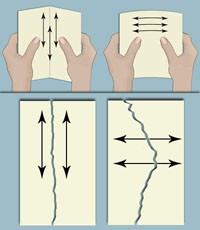 Paper folded against the grain can pucker and form uneven creases, and paper moistened with adhesive will stretch much more across the grain than along it. To determine grain direction in supplies, the paper can be flexed in both directions; the grain direction will offer less resistance. Another simple test can be performed by tearing the paper in both directions, as paper will always tear much more easily along the grain.
Paper folded against the grain can pucker and form uneven creases, and paper moistened with adhesive will stretch much more across the grain than along it. To determine grain direction in supplies, the paper can be flexed in both directions; the grain direction will offer less resistance. Another simple test can be performed by tearing the paper in both directions, as paper will always tear much more easily along the grain.
Because of the alarming rate of degradation of modern paper, a great deal of effort has gone into developing chemically stable papers, based mainly on alkaline buffered types. In recent years most Western countries have embraced alkaline paper production. Because paper manufacturing involving the old acid processes is known to pollute waterways, the atmosphere, and the soil, government regulations have pushed the industry to develop cleaner, less polluting processes.
Thus much of the paper now produced in industrialized countries is fortuitously nonacidic and alkaline. But cheap ground wood paper is still manufactured for newsprint and other impermanent uses. Such paper deteriorates rapidly and has led to serious “brittle paper” problems in libraries throughout the world. These problems are especially severe in developing countries, where much of the book paper production is acidic and the climate is unfavorable.
Condition Concerns
Paper is strongly affected by the environment. It is easily damaged by high humidity and temperatures, which hasten its chemical deterioration. Ground wood pulp paper deteriorates especially rapidly because of the chemicals it contains—principally acids and lignin—and soon becomes brittle. The widespread use of ground wood pulp paper, with its short, weak fibers and high acidity, causes serious problems for libraries and archives having to preserve materials that rapidly become brittle and unusable. Paper made from chemical wood pulp or even from rag can also deteriorate because of the use of harmful bleaches and sizingmaterials such as alum-rosin combinations. Because much of the world’s book paper after 1860 was produced from ground wood, all libraries and archives face a major crisis of preservation.
Diagnostic Tests
There are many tests to help determine the age and composition of paper, as well as to verify the basic stability of protective materials such as file folders. Testing the stability of protective materials is especially crucial, as acidic folders, portfolios, boxes, and the like can cause their contents to deteriorate through the migration of acids. Failure to use chemical methods to reverse or neutralize the acids in paper or to use chemically stable (acid-neutral or buffered) housing and storage can result in rapid deterioration. Housing that is alkaline can slow the deterioration substantially.
When a paper or board housing product is purchased, it is extremely important to ensure that it is chemically stable through some simple tests, whether or not the vendor advertises the supplies as “archivally sound” or “acid free.” The two main tests are for acidity and for lignin.
Testing for Acidity
The pH Test - There are several methods for testing the acidity of paper: titration tests through cold and hot extraction (these require a destructible sample, pH meters, and a closely controlled environment) and surface pH tests. The surface tests can be conducted using pH pens, a liquid chemical, or pH strips. For example, testing a piece of file folder stock requires the following supplies: 10-centimeter squares of Mylar (polyester film) and blotting paper, an eye dropper (or similar container) of distilled water, and pH strips.This test is best applied to enclosures, like folders, boxes, or boards. This test applied to historic artifacts can leave permanent stains.
- Place a piece of Mylar under the area to be tested and drop a spot of distilled water on the folder stock about 5 centimeters from any edge.

- Place the appropriate pH test strip color-side down on the wet area of the folder stock. The most useful ranges are 4-7 and 5-10. For stock that is likely to be acidic, use the 4-7 scale. For stock purported to be acid-free, use the 5-10 scale.
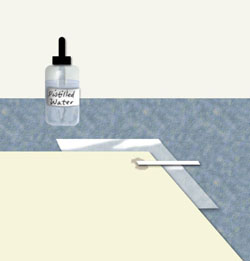
- Place a piece of Mylar on top of the strip to ensure that the strip makes full contact with the paper surface.

- If the paper or board to be tested is thick or has a noticeable coating on the surface, peel back a portion of the top layer and test the under-layer to gain a more accurate reading.
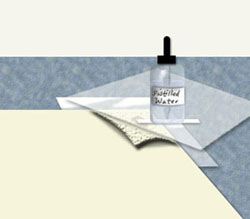
- After about 30 seconds pick up the test strip and compare it with the color code on the box. This should give a clear and unambiguous reading. If testing a page in a book, place a piece of blotting paper on top of and beneath the damp test area to avoid damaging adjacent pages.

Generally, a pH reading of 6 and above is considered fairly acceptable, but 7 and above is preferred. Below 6 is unacceptable for materials that come into contact with or enclose rare or unique materials.
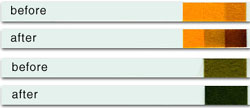

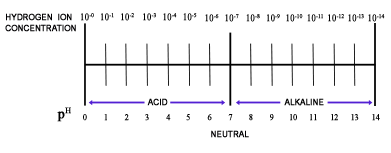 The Lignin Test - Lignin is an amorphous polymer that makes up 32 percent of wood and acts as a dimensional stabilizer by stiffening the cellulose fibers. But when wood is ground and pulped to make paper, lignin becomes unstable and causes the paper to darken, especially in the presence of light. It may also raise acidity levels. Lignin can be removed from wood pulp paper through the use of chemicals and bleach, especially with the sulfate process.
The Lignin Test - Lignin is an amorphous polymer that makes up 32 percent of wood and acts as a dimensional stabilizer by stiffening the cellulose fibers. But when wood is ground and pulped to make paper, lignin becomes unstable and causes the paper to darken, especially in the presence of light. It may also raise acidity levels. Lignin can be removed from wood pulp paper through the use of chemicals and bleach, especially with the sulfate process.
Chemical lignin testing using a destructible sample can determine the percentage of lignin in the paper. A simple check of supplies and enclosures can be done with a lignin testing pen, which shows a bright orange if lignin is present.